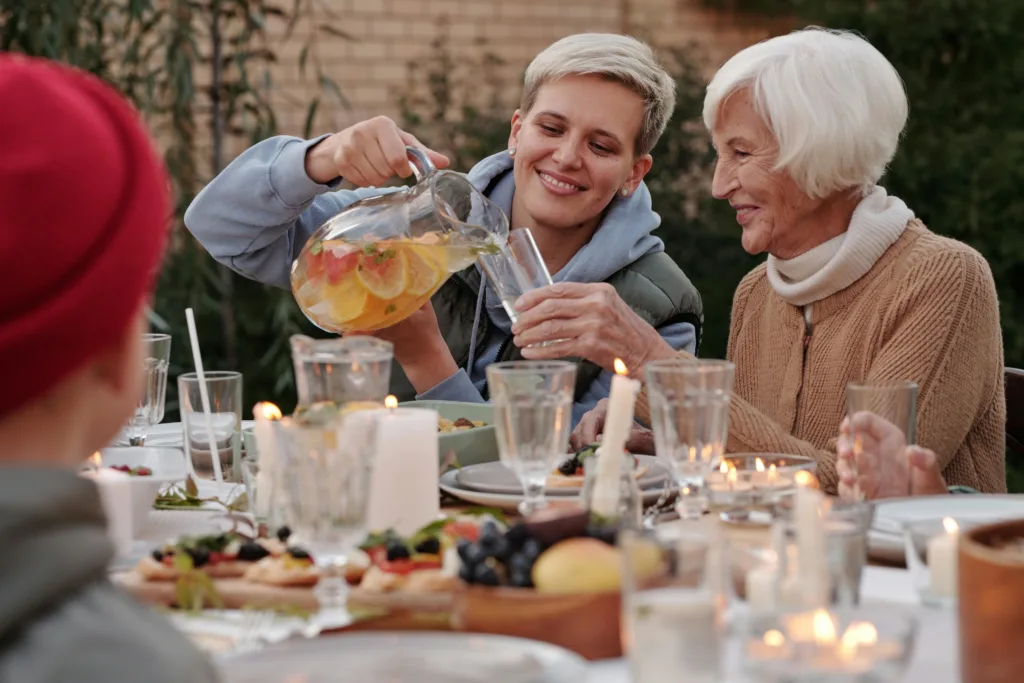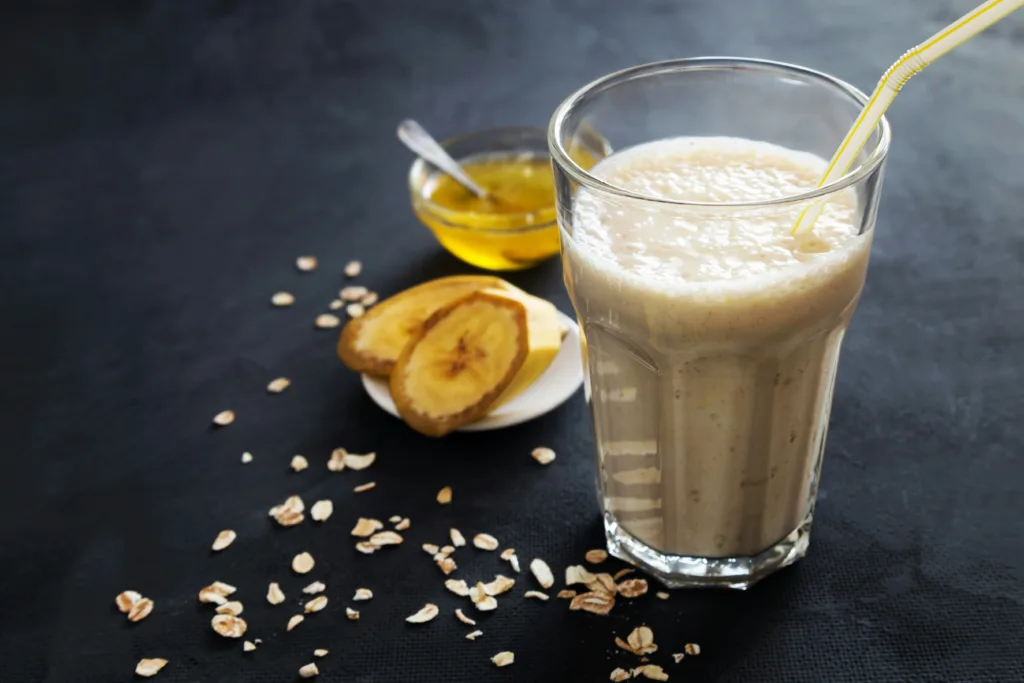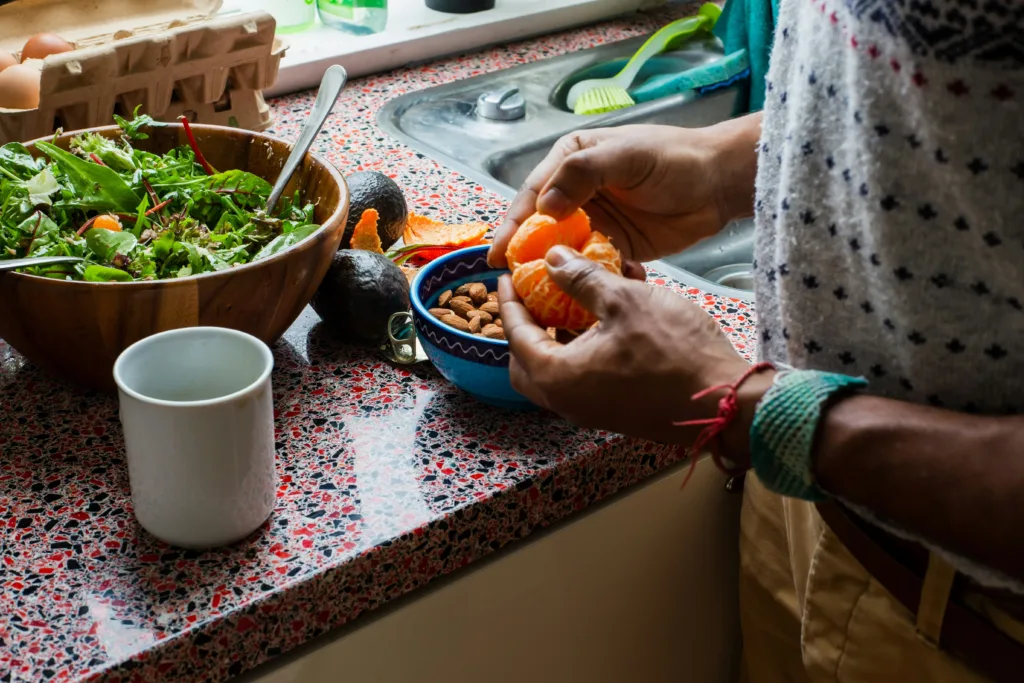Eating well gets more important as we get older, but let’s be honest, it also gets a bit harder. Smaller appetites, lower energy, and a long list of “shoulds” from every health blog can make meals feel more like a chore than a joy. This 7-day meal plan is here to change that. Whether you’re planning for yourself or helping a loved one, this guide keeps things simple, practical, and actually enjoyable. We’re talking balanced meals that are easy to prep, gentle on digestion, and full of ingredients that support strength, brain health, and energy. Think fewer decisions, more flavor, and a whole lot less stress.
That’s also where ReciMe can make a real difference. We built our app to take the pressure off meal planning, especially for those moments when cooking feels more like a chore than a joy. We know that as we age, nutrition matters more, but so does simplicity. That’s why ReciMe helps you save and organize your favorite recipes in one place, build smart grocery lists in seconds, and plan out meals without overthinking it. Whether you’re caring for a parent, cooking for yourself, or just trying to stay on top of healthy habits, our goal is to make food feel easy again – nourishing, stress-free, and maybe even fun.

Download for free from the App Store on iPhone and iPad

ReciMe Android App

Why Nutrition Needs Shift with Age
As we get older, our bodies go through natural changes. Muscle mass decreases, bones need more support, and digestion can slow down a bit. This all affects what and how we should eat.
Here are a few shifts worth knowing:
- Smaller appetites: Seniors often eat less, which means meals need to be more nutrient-dense to cover all the basics.
- Higher protein needs: To help maintain muscle strength and support healing.
- More fiber, less salt: For gut health and heart health.
- Increased need for calcium and vitamin D: To keep bones strong.
- Hydration is key: Older adults may not feel as thirsty but still need to stay well hydrated.
That’s why this plan is packed with fiber-rich veggies, lean proteins, healthy fats, and simple hydration reminders.
Tips to Make Meal Prep Easier
Cooking every single meal from scratch isn’t always going to happen. And that’s totally fine. A few smart habits can take a lot of pressure off during the week while still keeping meals balanced and satisfying.
- Batch cook where it makes sense: Pick a couple of base recipes that reheat well, like soups, stews, or roasted vegetables. Make a big batch and store them in the fridge or freezer for easy grab-and-reheat meals. It’s a time-saver and a sanity-saver.
- Prep snacks ahead of time: Having snacks like yogurt, cut fruit, veggie sticks, and nuts portioned out in small containers makes it easier to eat well without thinking too hard. You can prep a whole week’s worth in under 15 minutes.
- Keep meals colorful: A colorful plate usually means you’re getting a better mix of nutrients. Try to add greens, oranges, reds, and purples to your meals whenever possible. Not only is it good for your body, but it makes food look more appetizing too.
- Choose soft but satisfying: As we age, certain textures just work better. That doesn’t mean everything has to be mushy or boring. Foods like mashed sweet potatoes, stewed fruits, flaky baked fish, or blended soups are gentle but still feel hearty and nourishing.
- Use seasoning without the salt: Flavor doesn’t have to come from the salt shaker. Fresh herbs, lemon juice, garlic, a dash of vinegar, or even a sprinkle of grated cheese can brighten up a dish and make it feel special without raising sodium levels.

7-Day Meal Plan for Elderly Adults
This 7-day meal plan is made for real life. Each day includes simple, balanced meals that are easy to prep, gentle on digestion, and packed with the nutrients older adults need to feel strong and supported. There’s no calorie counting, no fancy ingredients, and definitely no boring food. Just real meals that help you stay healthy, energized, and satisfied.
Whether you’re cooking for yourself or helping someone you care for, this plan keeps things low effort and high reward.
Day 1
Breakfast
Start your morning with a bowl that feels like a hug: warm rolled oats cooked in milk (dairy or a calcium-fortified plant-based option like almond or oat). Stir until creamy, then top with sliced banana and a dusting of cinnamon. Want an extra boost? Add a teaspoon of ground flaxseeds for a little fiber and heart-healthy omega-3s. Finish it off with a small glass of water or herbal tea. Easy, cozy, and exactly the kind of breakfast that sticks with you in a good way.
Lunch
Keep things simple with a turkey and avocado sandwich. Use whole grain bread, a few slices of lean turkey breast, and half an avocado mashed with a bit of lemon juice. Add some soft lettuce or tomato slices if you’re feeling fancy. On the side, enjoy a handful of soft cucumber sticks (lightly steamed if chewing’s an issue) and a scoop of hummus for dipping. Finish with a small bunch of grapes. It’s balanced, satisfying, and won’t leave you feeling sluggish.
Snack
Plain Greek yogurt with a drizzle of honey is a great little pick-me-up. Stir in a spoonful of crushed walnuts or sunflower seeds if you like some crunch. It’s creamy, protein-rich, and just enough to hold you until dinner.
Dinner
Dinner tonight is a favorite for a reason. Bake a small cod fillet (around 3 to 4 ounces) with lemon juice, olive oil, and a sprinkle of herbs like dill or parsley. While it cooks, steam a handful of green beans until tender and whip up some sweet potato mash with just a splash of milk and a pinch of salt. For dessert, a small bowl of mixed berries does the trick. It’s a feel-good meal that checks all the boxes: protein, color, comfort.
Day 2
Breakfast
Scrambled eggs don’t need to be boring. Whisk up two eggs and cook them low and slow with a handful of chopped spinach and diced tomato. You want them soft and fluffy, not rubbery. Serve with one slice of toasted whole grain bread and a side of orange slices for a vitamin C boost. It’s a cozy, protein-rich way to start the day, with enough color to wake up your appetite.
Lunch
Lentil and veggie soup is your best friend today. It’s warm, filling, and easy to make ahead. Look for a version with carrots, celery, tomato, and maybe a little garlic. Heat it up and pair it with a slice of whole grain bread topped with a thick smear of fresh ricotta. Add a few apple slices on the side if you’re craving something sweet and crisp. The whole meal is balanced, fiber-rich, and comforting.
Snack
A small handful of walnuts is all you need. They’re crunchy, full of healthy fats, and help keep your energy steady. If you want to make it a bit more filling, pair them with a couple of dried apricots or half a banana.
Dinner
Whip up a chicken stir-fry using lean sliced chicken breast and whatever soft veggies you have on hand – think zucchini, bell peppers, snow peas. Cook everything in a pan with a splash of low-sodium soy sauce and a teaspoon of sesame oil. Serve over half a cup of cooked brown rice. To finish, a stewed pear with a spoonful of plain yogurt hits the sweet spot without going overboard.
Day 3
Breakfast
Start your day with something cool and effortless. Scoop half a cup of low-fiber cereal into a bowl and top it with a few dollops of plain yogurt. Toss in a handful of fresh blueberries (or frozen if that’s what you’ve got) and give it a gentle stir. You get fiber, protein, and just the right touch of sweetness. Enjoy it with a warm cup of green tea or whatever morning drink feels right to you.
Lunch
Egg salad doesn’t have to be boring. Mash two hard-boiled eggs with a spoonful of Greek yogurt or a little mayo, a pinch of mustard, and some black pepper. Spread it on a slice or two of rye or whole grain bread and add thin cucumber slices on top or on the side for crunch. Serve with a small, ripe peach for something juicy and fresh to balance it all out. It’s light but still filling.
Snack
Boil a couple of eggs ahead of time and keep them in the fridge. Grab one or two in the afternoon if you need a snack. Add a dash of salt and pepper or a sprinkle of paprika if you’re feeling fancy. Simple, protein-packed, and no prep when you’re low on energy.
Dinner
Tonight’s dinner feels a little special, but it’s still super easy. Take a small sweet potato, bake it until tender, then cut it open and stuff it with black beans, corn, and shredded cheese. Pop it back in the oven for a few minutes until everything gets melty and golden. On the side, mix up a small salad with soft greens, a few cherry tomatoes, and a splash of olive oil and vinegar. It’s warm, filling, and full of flavor.
Day 4
Breakfast
Today’s breakfast is all about crunch and color. Pour a bowl of whole grain cereal (something low in sugar and high in fiber) and top it with a spoonful of crushed almonds for a little texture. Add your favorite milk, then slice up a kiwi or scoop out the green goodness with a spoon. It’s quick, it’s energizing, and it gives your body a gentle, nourishing start to the day.
Lunch
Hearty, plant-based, and super satisfying. Heat up a bowl of chickpea and vegetable stew, this one’s perfect to batch cook ahead of time. Think tomatoes, soft carrots, zucchini, and chickpeas all simmered together with garlic, cumin, and olive oil. Serve it with a warm whole wheat pita on the side for dipping. Peel a clementine afterward for something fresh, sweet, and full of vitamin C.
Snack
When your stomach needs a little something between meals, go for cheese and crackers. Pick a slice or two of your favorite soft cheese and pair it with a few whole grain crackers. It’s a great combo of protein, calcium, and crunch. Add a couple of grapes or a slice of apple if you’re in the mood.
Dinner
Time to bring out the comfort food. Roast a small pork loin (or a pork chop if that’s easier) until juicy and golden. Serve it with a mix of roasted root veggies like carrots, parsnips, and pumpkin. Keep it simple, just a drizzle of olive oil, salt, pepper, and roast until tender. On the side, spoon out half a cup of quinoa with fresh chopped parsley or herbs for a bit of brightness. It’s hearty, satisfying, and surprisingly low effort.

Day 5
Breakfast
Kick things off with a smoothie that feels like a boost in a glass. Blend one banana, a handful of baby spinach, a spoonful of protein powder (optional), and a cup of milk or dairy-free alternative. Toss in a few frozen berries if you’ve got them for extra fiber and flavor. Pair it with a toasted whole grain muffin for something you can chew on. You’ll feel fueled, not weighed down.
Lunch
A classic tuna salad, but with a fresh, no-fuss twist. Mix canned tuna with a little olive oil, lemon juice, and pepper. Serve it over a bed of soft greens or with whole grain crackers on the side. Add a handful of cherry tomatoes for crunch and color. Finish it off with a cup of strawberries or whatever fruit you have lying around. It’s the kind of lunch that’s easy to assemble and easy to enjoy.
Snack
If you need something between lunch and dinner, go for a small bowl of low-sugar custard or pudding. It’s soft, creamy, and just enough to feel like a treat without going overboard. If you want more texture, top it with a pinch of chopped nuts.
Dinner
Tonight’s all about warm, homey flavors. Cook up a few turkey meatballs in marinara sauce (you can use store-bought or make a simple version with crushed tomatoes, garlic, and herbs). Serve with mashed cauliflower instead of pasta for a lighter touch, and add a side of roasted zucchini with a sprinkle of parmesan or herbs. It’s cozy, filling, and packed with protein and veggies.
Day 6
Breakfast
Today’s breakfast is cool, creamy, and packed with protein. Scoop half a cup of cottage cheese into a bowl and top it with sliced pineapple and a sprinkle of chia seeds. You get sweet, juicy, crunchy, and soft all in one bite. If cottage cheese isn’t your thing, swap it for plain yogurt. Sip a warm cup of tea alongside: black, green, or herbal, whatever feels right.
Lunch
Lunch is a grilled chicken wrap that doesn’t take much effort but feels like something you’d order at a café. Use a whole grain wrap and layer in sliced grilled chicken, soft lettuce, and avocado slices. Add a smear of hummus or plain yogurt if you like things creamy. Serve with a few slices of fresh melon — it’s refreshing and hydrating, especially on warm days.
Snack
Yogurt can absolutely be a healthy snack. Choose a low-sodium option.
Dinner
Dinner’s a colorful veggie pasta that’s easy to pull together. Cook whole wheat pasta and stir in a quick tomato sauce with soft, sautéed veggies like zucchini, mushrooms, and spinach. Add a handful of cooked lentils for protein and fiber. Serve with a side of steamed broccoli and a drizzle of olive oil. It’s one of those meals that feels hearty without being heavy.
Day 7
Breakfast
Start the day with something light but satisfying. Toast a slice of wholemeal bread and spread on a quarter cup of ricotta cheese. Top with half a sliced banana and a few peach slices (fresh or canned in juice, drained). Roll it into a wrap or leave it open-faced. It’s creamy, naturally sweet, and packed with protein and calcium. Drink a glass of milk or your favorite fortified milk alternative on the side.
Lunch
Today’s lunch is a little more special: a roast lamb and quinoa salad that’s full of flavor and texture. Use leftover roast lamb if you have it, or pan-fry some thinly sliced lamb with a touch of olive oil and herbs. Toss it with cooked quinoa, chopped cucumber, cherry tomatoes, crumbled feta, and a handful of baby spinach. A drizzle of olive oil and lemon juice ties it all together. Round it out with a small yogurt cup – plain or lightly sweetened.
Snack
Keep it simple and satisfying: slice up an apple and spread a thin layer of peanut butter on each slice. It’s a classic combo for a reason – fiber, protein, and healthy fat, all in a few bites.
Dinner
Wind down with a warm egg and veggie frittata. Whisk two eggs with a splash of milk, then add in soft-cooked veggies like sautéed onions, spinach, and mushrooms. Pour into a small skillet and cook gently until set. Serve with roasted asparagus on the side and a cup of fresh pineapple for a naturally sweet finish. It’s light, colorful, and easy to digest – perfect for an evening meal.
You don’t need a complicated diet to stay healthy as you age – just thoughtful, steady meals made from real ingredients. This plan is meant to be flexible, so don’t stress about following it perfectly. Swap in your favorite fruits, veggies, or proteins. Repeat meals you love. Skip snacks if you’re not hungry.
At the end of the day, the goal is simple: eat well, feel good, and make mealtimes something to look forward to.

Helpful Add-Ons to Keep in Mind
These aren’t rules – just smart, low-effort habits that can make a big difference in how meals feel and how well they support your health.
Hydration
It’s easy to forget, but staying hydrated is just as important as eating well. As we age, thirst cues can become less noticeable, so it helps to build hydration into your routine. Start by serving a glass of water with every meal. Not a fan of plain water? Add a slice of lemon, a few mint leaves, or even a splash of juice to make it more enjoyable. Herbal teas, broths, or even water-rich fruits like melon and cucumber can also help you stay on track.
Seasonal Swaps
Don’t feel locked into specific fruits or vegetables. Go with what’s in season, on sale, or already in your fridge. Fresh peaches in summer? Great. Apples in the fall? Even better. Seasonal produce is usually more flavorful and more affordable, which makes eating healthy that much easier.
Leftovers = Less Work
One of the best time-savers is planning for leftovers. Roasted veggies from dinner can go into tomorrow’s omelet. Extra grilled chicken? Toss it in a wrap or salad for lunch. Making meals that stretch across days cuts down on waste, reduces prep time, and helps you eat better without starting from scratch every time.
Supplements (If Needed)
Sometimes, even the best meal plans need a little backup. As we get older, it can be harder for our bodies to absorb certain nutrients, especially vitamin D, vitamin B12, and calcium. If you’re not getting enough from food, a doctor or dietitian might suggest supplements to help fill the gaps. But always check with a healthcare provider first, no need to DIY the vitamin aisle.
Final Thoughts
Healthy eating after 60 isn’t about perfection. It’s about creating meals that work for your lifestyle, support your body, and still taste good. This meal plan is a starting point – a flexible, no-stress guide built to help older adults eat well without overthinking it.
Whether you follow it day by day or pick and mix based on what sounds good, the goal stays the same: feel nourished, supported, and satisfied at every meal.
You don’t need to cook fancy or follow complicated rules. Just stick to real food, stay hydrated, and eat in a way that makes you feel good. That’s what healthy aging really looks like.
Frequently Asked Questions
Can I repeat the same meals more than once during the week?
Absolutely. If you find a meal that you or your loved one really enjoys, feel free to repeat it. The plan is here to give you structure, but it’s not a rulebook. Repeating meals can also make grocery shopping and prep even easier.
What if my loved one has difficulty chewing or swallowing?
You can easily adapt this plan by choosing softer ingredients and cooking vegetables until they’re very tender. Foods like mashed sweet potato, scrambled eggs, soft fruits, soups, and stews are great options. Avoid tough meats or anything too crunchy unless it’s been softened.
How do I adjust portion sizes for someone with a smaller appetite?
Start small. Serve smaller portions and offer snacks throughout the day if full meals feel overwhelming. The goal is to get a steady intake of nutrients, don’t worry if it doesn’t all happen in one sitting.
Can I batch cook any of these meals?
Definitely. Dishes like soups, stews, roasted vegetables, frittatas, and cooked grains like quinoa can all be made ahead and stored in the fridge or freezer. Planning leftovers into your week saves time and reduces food waste.
Is this meal plan suitable for people with diabetes or high blood pressure?
It can be. This plan emphasizes whole foods, healthy fats, lean protein, and lots of fiber – all good things for managing blood sugar and supporting heart health. That said, it’s best to check with a healthcare provider or dietitian if you’re managing a specific condition.
